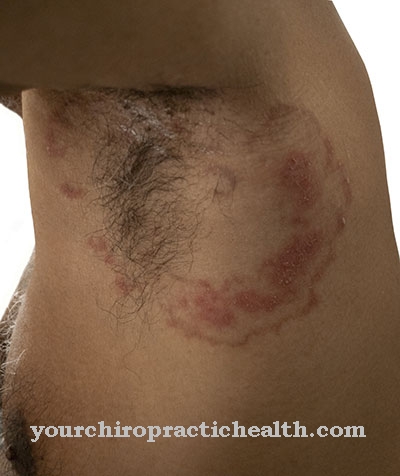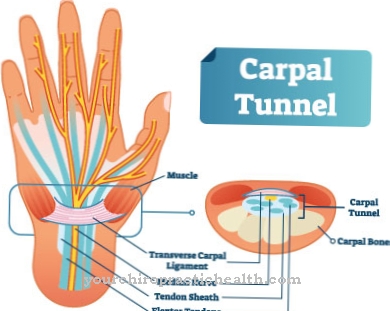Under Hammer toe such as Claw toe one understands misalignments of the toe joints, visible through the curvature of one or more toes. The hammer toe (claw toe) can initially be corrected by conservative methods, but in an advanced stage only by surgical measures.
What is a hammer toe (claw toe)?
.jpg)
© aytuncoylum - stock.adobe.com
The mostly painful deformations of individual toes are known as hammer toes or claw toes. You can recognize these misalignments by the curvature of the toe joints.
One speaks of a hammer toe when the toe joint is bent when the base joint is extended. If you suffer from a claw toe, the middle or end joint is curved, while the metatarsophalangeal joint is overstretched.
Both toe misalignments can be diagnosed relatively often, with the hammer toe being predominant. It often happens that in addition to the malformation of the hammer toe or the claw toe, a deformation of the big toe can also be observed. One speaks here of "Hallux Valgus".
causes
What are the causes of the pathological development of the hammer toe or the claw toe? Above all, wearing shoes with too high heels or too tight shoes is responsible. The toes do not have enough space. They hit the toes of your shoes and can therefore gradually bend.
Since the toe muscles are hardly moved nowadays - especially because the foot usually remains wedged in orthopedically unfavorable shoes all day - they atrophy and the development of the hammer or claw toe is only a matter of time.
However, a misalignment of the foot such as splay, flat or articulated feet can promote the development of a hammer toe and claw toe.
Neurological diseases and muscle or nerve injuries to the foot or the lower leg can also be the cause. More rarely, genetic factors are responsible for the hammer toe or the claw toe.
Symptoms, ailments & signs
The hammer toe or claw toe has a characteristic appearance. The main symptom is a typical toe malposition in which the middle toe is hyperextended upwards and the tip of the toe is pointing downwards. The shape of the toe thus resembles that of a hammer. The difference between a hammer toe and a claw toe is that in the former, the tip of the toe touches the ground. In many of those affected, more than one toe of the foot is affected by a misalignment.
In many cases, apart from purely cosmetic aspects, those affected are symptom-free. For others, the misalignment of the toes creates instability, which can lead to pathological stress on the foot. This is especially the case when multiple toes of the foot are deformed. This can lead to pressure points and severe pain.
In advanced stages, there is further deformation of the hammer toe or claw toe. The pain will increase over time. The affected toe is shortened further and at the same time requires more space in height. Wearing shoes that are too tight can lead to the development of corns or painful calluses.
course
The hammer toe, or the claw toe, develops relatively inconspicuously at first: one day you observe a small bump on one or more toes. If you fail to visit the orthopedic surgeon in good time, the small bony changes gradually result in unsightly bumps.
The toe deforms more and more, the middle or end joint bends and hits the top of the shoe. The result: pressure points on the toe make walking a painful ordeal. Corns develop, which can easily become inflamed and cause infections due to constant rubbing on the shoe.
Diabetics are particularly at risk due to the extreme sensitivity of their feet.Failure to timely treatment of the hammer toe (claw toe) can lead to complete crippling and stiffening.
Complications
The hammer toe causes various complaints and malformations on the toes. The further course of the disease usually depends heavily on the exact complaints and symptoms. In most cases, however, the diagnosis of the disease is delayed by the patient himself. The reason for this is that the symptoms are initially inconspicuous and cannot be attributed to the hammer toe.
Obvious symptoms and changes in the bones only occur later. The toes become crooked and can cause severe pain. These occur mainly while running and can lead to movement restrictions. It is not uncommon for so-called corns to occur.
Furthermore, the affected person can easily develop inflammation and infections on the toes. The feet are particularly sensitive due to the disease. The treatment of the hammer toe usually depends on its severity. In many cases, no surgery is necessary. There are no further complications. The symptoms can be alleviated with various insoles, therapies or implants. Life expectancy is not restricted by the hammer toe.
When should you go to the doctor?
A hammer toe does not always cause discomfort and usually does not require any treatment. However, if there is pain or further deformities, a visit to a doctor is recommended. If bruises and corns develop in connection with a claw toe, orthopedic measures must be taken. Infections, bleeding and other complications also require rapid diagnosis and treatment by a specialist. Diabetics are particularly prone to hammer toe.
If the first signs of a deformity are noticed, the responsible doctor should be informed. Hammer toes are also more common in people who suffer from splayfoot, flat or knee joint. Other risk factors are tight or improperly fitting shoes, neurological diseases, and muscle or nerve injuries.
Anyone who belongs to these risk groups should have the first symptoms clarified directly and, in the event of acute complaints, visit a doctor's practice within the next few days. If ulcers or infections develop as a result of the hammer toe, this must be treated immediately, otherwise the symptoms can become severe.
Doctors & therapists in your area
Treatment & Therapy
If the deformity to the hammer toe or claw toe is not yet very pronounced, conservative, i.e. non-surgical, treatment is advisable. The orthopedic surgeon prescribes, for example, special shoe inserts or night splints that are designed to stretch the toe overnight.
He prescribes toe exercises from the physiotherapist. It is also essential to wear comfortable shoes made of soft leather. The pressure points can also be relieved with special pads. Regular visits to the podiatrist are also recommended. The focus here is on treating the corns.
The malformation of the hammer toe (claw toe) can usually not be reversed by conservative therapy. For more severe deformations, only surgery will help. There are various ways of eliminating the curvature of the toes: The surgeon inserts an implant such as the SMART TOE®, a newer and very successful method, into the affected toe.
This stiffens the toe joint, but it is stretched and returned to its original shape. Another method is to remove the affected bone while rebuilding the tendons and muscles. The operation of the hammer toe or the claw toe is usually carried out on an outpatient basis under local anesthesia.
Outlook & forecast
The prognosis of a hammer toe is based on the severity of the deformity and the age of the patient. If the person concerned is still in the growth and development phase, corrections can be made by wearing shoes or by doing special exercises on the limbs. If the hammer toe is only slightly pronounced, the prognosis for the patient is favorable. In many cases, healing can be achieved within a few months if all requirements are successfully implemented.
With the completion of the growth phase, the prospect of a complete correction usually deteriorates. Nevertheless, significant improvements can be achieved with orthopedic measures and individual gymnastics of the toes.
If there is a severe malformation of the toes, a correction can only lead to an alleviation of the existing symptoms through a surgical intervention. If the operation is carried out without further complications, an improvement in the quality of life is achieved in most cases. Freedom from symptoms is rarely possible, but not excluded.
The later medical care is initiated and the more severe the malformation, the less favorable the prognosis for the patient. In severe cases, the disease can be expected to progress or the toe and ankle joint must be stiffened. This prevents an increase in discomfort along the foot or leg.
prevention
So that the hammer toe or claw toe does not develop in the first place, the following preventive measures should be carried out: Above all, comfortable, not too tight shoes with heels not exceeding three centimeters are important. Regular toe exercises are also helpful.
When walking, make sure that your feet roll properly - so the toes are not clawed in. Anyone who consistently pays attention to the health of their feet does not have to worry about suffering from hammer or claw toe.
Aftercare
During the surgical correction of hammer toes, joints, tendons and bones are affected. So that the toe remains in the target position, it is fixed with tape bandages or a splint and wires. The tape bandages must be checked regularly and replaced if necessary. Wires are usually removed after fourteen days as part of follow-up care.
In order for the toes to regain their previous mobility, physiotherapy is almost always necessary and should be started as early as possible. As part of this therapy, the basic joints are trained and the long tendons are stimulated. Initially, this can be accompanied by pain.
It is therefore desirable that patients do not initially practice alone, but under the guidance of a trained physiotherapist. Initially, two to three sessions per week are usually required. As soon as the pain subsides, patients can and should practice on their own.
It is important to regularly check the success of the therapy. After about six weeks, your toes should be able to be angled 30 degrees up and about 10 degrees down with your feet straight. Further targets are to be defined for the following weeks.
In order for the operation to be successful in the long term, the affected person usually has to adapt their behavior. In particular, if the hammer toes were triggered or reinforced by the wrong footwear, shoes with high heels or a pointed shape are generally taboo in the following years and should only be worn as an exception and then only for a few hours.
You can do that yourself
A hammer toe is not necessarily a medical emergency. If it is recognized at an early stage, the malalignment of the foot can be corrected independently through targeted foot gymnastics and orthopedic measures. A medical clarification is therefore essential. In consultation with the doctor, the footwear can then be checked and adjusted if necessary.
Possible triggers for a claw foot are small or too narrow shoes that are too tight, especially in the toe area. If the pressure is light, it is sufficient to adjust the shoes individually. One option is to widen the toe to give your toes more space. Alternatively, the shoes can be equipped with so-called felt rings. These reduce the pressure on the sensitive toes and prevent pressure points.
An orthopedic surgeon should be consulted in the event of significant misalignments. They can recommend orthopedic insoles and, in severe cases, suggest an operation to correct the deformity. In any case, a hammer toe should be professionally examined and, depending on its severity, supported or corrected. If the misalignment remains untreated, the claw foot will increase over time and cause further complications.



.jpg)




.jpg)



















